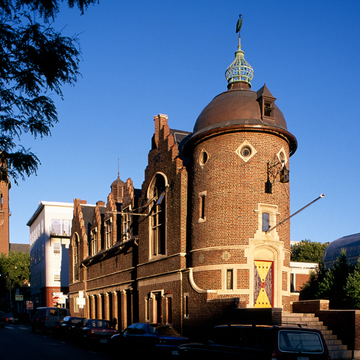In the late nineteenth and early twentieth centuries, the area to the south of Harvard Yard was built up with private clubs and dormitories for the college's wealthier undergraduates. The Gold Coast, as the area became known, resulted from President Charles W. Eliot's decision to encourage the private market to provide student housing while the university's resources were directed to expanding educational facilities.
Final clubs, so-called because they served upperclassmen, may be found in unmarked buildings on or near Mount Auburn Street. The Fox Club (1906, 44 Kennedy Street),
The whimsy of Edmund Wheelwright's Harvard Lampoon building (1909, 59 Mount Auburn Street, NR) reflects the fact that it is the home of Harvard's student humor magazine, founded in 1876. Sited on the triangle formed by Bow and Mount Auburn streets, it deliberately conjures up the form of a recumbent animal, its face defined by oculus windows, a lantern, and another window. Flemish stepped gables and dormers along the flanks of the building climax in the circular corner tower surmounted by copper dome and ibis finial, the mascot of the club.
Claverly Hall (1892, 63 Mount Auburn Street, NRD), by George Fogerty, was the first Gold Coast dormitory to be erected. With steam heating and private bathrooms for every suite, it was luxurious by the standards of the old Harvard Yard dormitories. The two-story arched granite entrance, circular corner towers, and deeply projecting cornice give the brick apartment building a monumental scale. Randolph Hall (1897, 45–57 Bow Street, NRD), by Coolidge and Wright, another brick apartment building with Jacobean gables, included squash courts among the luxuries for its occupants. It was built in the front garden of the East Apthorp House (c. 1760, 10 Linden Street), one of the finest residences of colonial Cambridge. The clapboard fivebay residence with monumental pilasters at the corners and framing the central pavilion may have been the work of Peter Harrison, architect of Christ Church (RA3), for which Apthorp was the first rector, but no documentation has ever been found. In 1916, Randolph Hall and East Apthorp House were bought by Harvard and incorporated into Adams House in 1930–1931, along with Westmorely Court (1898, Warren and Wetmore), another former Gold Coast dormitory. East Apthorp House serves as the Master's Residence for Adams House.


